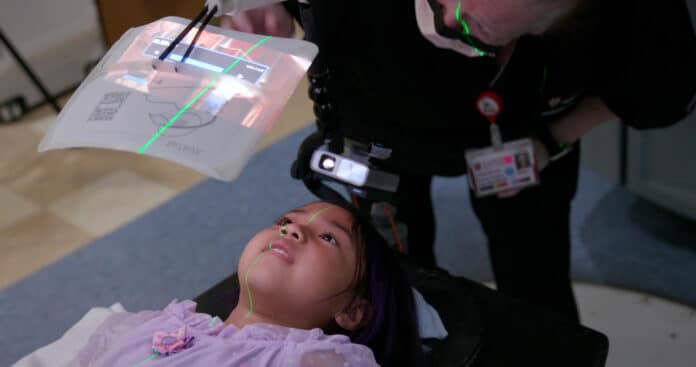Cancer radiotherapy can be a traumatic experience for pediatric patients, often requiring general anesthesia to keep them still during the procedure. However, a new study led by Stanford Medicine found that an audio-visual assisted therapeutic ambiance system, AVATAR, can significantly reduce the need for anesthesia by distracting children with engaging videos.
The study’s findings suggest that AVATAR is a promising and feasible tool for reducing the trauma associated with cancer treatment in children.
A Stanford-led study has found that watching distracting videos during radiation treatments helps children with cancer avoid anesthesia. The study, which involved 81 children between the ages of 3 and 10 being treated for cancer at ten pediatric hospitals in the United States, also showed that video-based distraction reduced anxiety and improved their quality of life. The findings were published in the International Journal of Radiation Oncology, Biology, and Physics.
“It’s very important that patients don’t move during radiation treatment, and that they’re not upset or having a traumatizing time during treatment,” said co-senior study author Susan Hiniker, MD, assistant professor of radiation oncology at the Stanford School of Medicine. Hiniker is a radiation oncologist at Stanford Medicine Children’s Health and Stanford Health Care and was part of the team that developed the video setup.
“Many young kids can almost cooperate with the treatment, but being alone in a treatment room for 20 to 30 minutes and having to be really still can be quite challenging,” she said. “If we can get them engrossed in paying attention to something, such as a video they enjoy, that really helps.”
Dr. Hiniker and Dr. Bush share senior authorship of the study, with co-lead authors Paulina Gutkin and Dr. Lawrie Skinner. The study found that most young children who need radiotherapy receive general anesthesia, which has disadvantages such as risks to children’s brains, overnight fasting, increased treatment cost, and more poking and prodding.
For many children, “zoning out” to a favorite video is a better option, the researchers found — especially given that children may need up to 35 sessions of radiation treatment, usually delivered five days a week for multiple weeks.
“We think, for kids and their families, the experience over those weeks of treatment really matters,” Hiniker said.
A video-viewing setup developed at Stanford Medicine, Children’s Health, helps children with cancer avoid anesthesia during radiation therapy, according to a study published in the International Journal of Radiation Oncology, Biology, Physics. The setup consists of a wireless projector and a radiation-permeable plastic screen. Children could select the videos they wanted to watch, and 78% could hold still through at least one 10- to 30-minute radiotherapy session without anesthesia. Video distraction also reduces anxiety and improves quality of life. The gains were greatest for 3- and 4-year-olds, who typically need anesthesia during radiotherapy. The cost savings from avoiding anesthesia in the current study are estimated at $2.3m.
Pediatric patients 3 to 10 years of age preparing to undergo RT at 10 institutions were prospectively enrolled. Children who are able to undergo at least 1 fraction of RT using AVATAR without anesthesia were considered successful (S). Patients requiring anesthesia for their entire treatment course were nonsuccessful (NS). The PedsQL3.0 Cancer Module (PedsQL) survey assessed the quality of life and was administered to the patient and guardian at RT simulation, midway through RT, and at final treatment. The modified Yale Preoperative Anxiety Scale (mYPAS) assessed anxiety and was performed at the same 3-time points. Success was evaluated using the χ2 test. PedsQL and mYPAS scores were assessed using mixed effects models with time points evaluated as fixed effects and a random intercept on the subject.
This study found that AVATAR video distraction reduced the need for anesthesia during radiation therapy for 78% of children aged 3 to 10 years. This is higher than in previous studies, where only 49% of children could avoid anesthesia. The study suggests that AVATAR is a feasible and effective way to help children undergoing radiation therapy and should be further studied and made available to patients who could benefit from it.
Journal Reference
- Paulina M. Gutkin, Lawrie Skinner, Alice Jiang, Sarah S. Donaldson, Billy, W. Loo Jr, Justin Oh, Yi Peng Wang, Rie von Eyben, John Snyder, Jeremy S. Bredfeldt, John C. Breneman, Louis S. Constine, Austin M. Faught, Daphne Haas-Kogan, Jordan A. Holmes, Matthew Krasin, Charlene Larkin, Karen J. Marcus, Peter G. Maxim, Shearwood McClelland III, Blair Murphy, Joshua D. Palmer, Stephanie M. Perkins, Colette J. Shen, Stephanie Terezakis, Karl Bush, Susan M. Hiniker. Feasibility of the Audio-Visual Assisted Therapeutic Ambience in Radiotherapy (AVATAR) System for Anesthesia Avoidance in Pediatric Patients: A Multicenter Trial. International Journal of Radiation Oncology, Biology, Physics. DOI: 10.1016/j.ijrobp.2023.03.063
